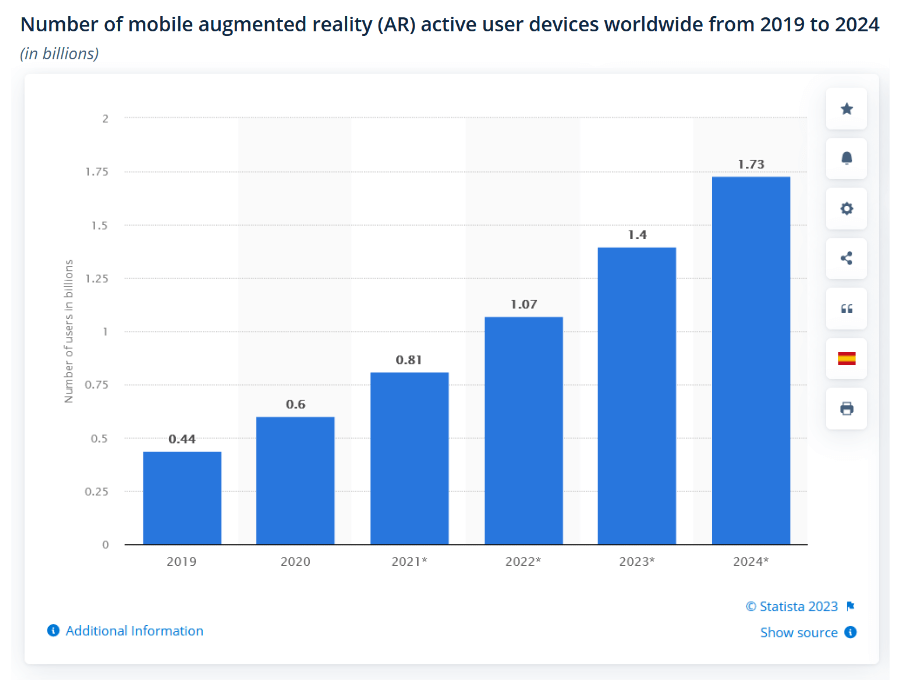AR and VR are two of the most promising technologies of the modern era. Both can potentially revolutionize how we interact with the world around us. However, these technologies have taken a long time to reach their full potential.
While AR and VR have been around for decades, it wasn’t until recently that they offered a quality experience without being too limited by technological constraints or not being portable enough for widespread use.
Nevertheless, they’ve been making waves in many industries. And now, the e-commerce industry is hopping on board. Statista reports that by 2023, there will be 1.4 billion AR devices worldwide, projected to rise to 1.73 billion by 2024.

What should we expect from AR and VR in 2023 and beyond? In this article, we will explore the potential of AR and VR for e-commerce and how they can enhance your shopping experience.
1. Increased Adoption of AR in E-Commerce
According to a recent survey, 38% of marketers reported using AR in 2022. It’s a significant increase from the 23% reported in 2017. And it’s understandable, given AR technology’s benefits to e-commerce customers.
For example, it allows them to feel like they’re physically interacting with products in a brick-and-mortar store while being online. AR can also help consumers visualize how products will look in their homes or on their bodies, improving the shopping experience and leading to more informed purchasing decisions and fewer returns.
Looking ahead to 2023, there are six exciting trends in the AR shopping space to keep an eye on. They are:
1. Social Media Apps and Camera Filters
Social media apps and camera filters, with Snapchat and Instagram leading the charge by incorporating AR into their platforms. Brands can use SnapAR Lens Studio or Meta Spark to create engaging AR filters and lenses that bring products to life. A case in point is Gucci.

2. Virtual Try-On Technology
Virtual try-on technology to see how products look on shoppers like on the Sephora Snapchat page.

3. Virtual Showrooms
Virtual showrooms are similar to try-on but involve the buyer flipping the camera around. For example, it’s popular among furniture stores like EQ3.

4. Better AR Hardware Options
Better AR hardware options, caused by innovations in mobile technology, such as LiDAR and ToF (depth sensing hardware). Companies like Google, Microsoft, Lenovo, and Vuzix are developing smart glasses to enhance the AR experience.
5. AR Mirrors
AR mirrors for in-store shopping, assisting buyers who are in-store and either don’t want to test various alternatives or can’t for whatever reasons.
6. Gamifying
Gamifying in-store shopping to connect physical products with apps, creating a fun and interactive shopping experience.
2. VR-Enabled Online Shopping Experiences
VR creates an immersive visual environment, including 360-degree videos, photos, product demos, and complex experiences using devices such as the HTC Vive or Oculus Quest.
Unlike AR, VR is entirely simulated and disconnected from the physical world. VR can benefit businesses in various ways, such as:
- virtual tours of showrooms and stores;
- visualization of products;
- greater user engagement;
- increased consumer trust;
- enhanced conversion rates;
- better retention rates;
- improved customer service.
However, it’s essential to remember the “shiny toy syndrome” and avoid it. Ensure that VR experiences align with your business goals and customer needs before opting for them. E-commerce stores can use VR for the following purposes:
- virtual stores with virtual clothing racks, an opportunity to meet with friends and shop together online;
- “try before you buy”;
- in-store experiences;
- live events;
- interactive education.
3. Introducing AI Into AR and VR Solutions
Artificial intelligence can integrate with AR and VR technologies to revolutionize the shopping experience. AI-powered 3D representation of products in a user’s environment can increase conversions. How? Here is how AI can enhance virtual experiences:
1. Object Recognition
AR and VR experiences can adjust to the user’s movements and actions thanks to AI algorithms’ ability to detect and track things in real time.
2. Computer Vision
It involves image recognition and tracking, enabling the system to respond to the environment.
3. Natural Language Processing (NLP)
NLP is about using voice commands for people to explore and interact with virtual worlds.
4. Predictive Analytics
As AI can predict user behavior, merchants can build personalized and proactive experiences.
5. Usage Analytics
AI can also help analyze usage data and client feedback. You can optimize your AR/VR services and boost buyer satisfaction based on the results.
6. Personalized Experiences
One of the ways to employ customer insights is to tailor offers to their tastes. It can boost satisfaction and sales.
4. Creating Digital Twins
The past year has seen an increase in AR and 3D technology use by fashion brands to boost sales and brand recognition in physical and virtual worlds. And in 2023, we can expect more brands to utilize AR innovatively.
It includes the ability to try on digital versions of physical clothing on your avatar. Another example is unlocking special effects for physical apparel. Some brands create digital-only looks that users can capture on camera and share on social media.
This trend becomes possible thanks to avatar platforms and AR features such as image targets and body tracking. So brands can offer and sell virtual goods. And with NFC (Near Field Communication) and QR codes embedded in physical apparel, you can transform one thing (for example, a T-shirt) into infinite designs.
5. Security Concerns Over the Usage of AR and VR
Consumers are increasingly concerned about privacy, security, and safety in computing. The metaverse, new headsets, and more AR and VR content have made safety a greater focus. Devices can now gather more information through eye and hand tracking. AR also relies on spatial data to immerse users. That’s why customers remain skeptical about using such devices daily.
How can people safely enjoy digital realities? We need new frameworks, regulations, and social contracts prioritizing safety. All these require collaboration through working groups, policy and standard discussions, and new software solutions for moderation and cyber threats.
Final Word
To sum up, AR and VR can enhance the e-commerce industry by improving the customer experience, driving more engagement, and cutting costs. But there are many challenges to overcome before these technologies can become mainstream.
For example, some websites are incompatible with VR headsets or AR apps. Why? The reason is that they were not built with those devices in mind. And not everyone owns a headset or smartphone capable of using these technologies.
That’s why e-commerce merchants should take advantage of these new opportunities to not lose potential clients due to incompatibility issues. As these technologies get better, more online stores will use AR and VR to give shoppers immersive shopping experiences. The future of e-commerce is exciting. And augmented and virtual reality are sure to play a significant role in shaping it.
Guest PostAbout the Guest Author(s)

Art Malkovich
Art Malkovich is CEO and co-founder of Onilab, an e-commerce development company. He has about 10 years of experience in team management and web development. He is passionate about keeping up with recent technologies and working on innovative projects like headless commerce solutions and PWAs in particular.




